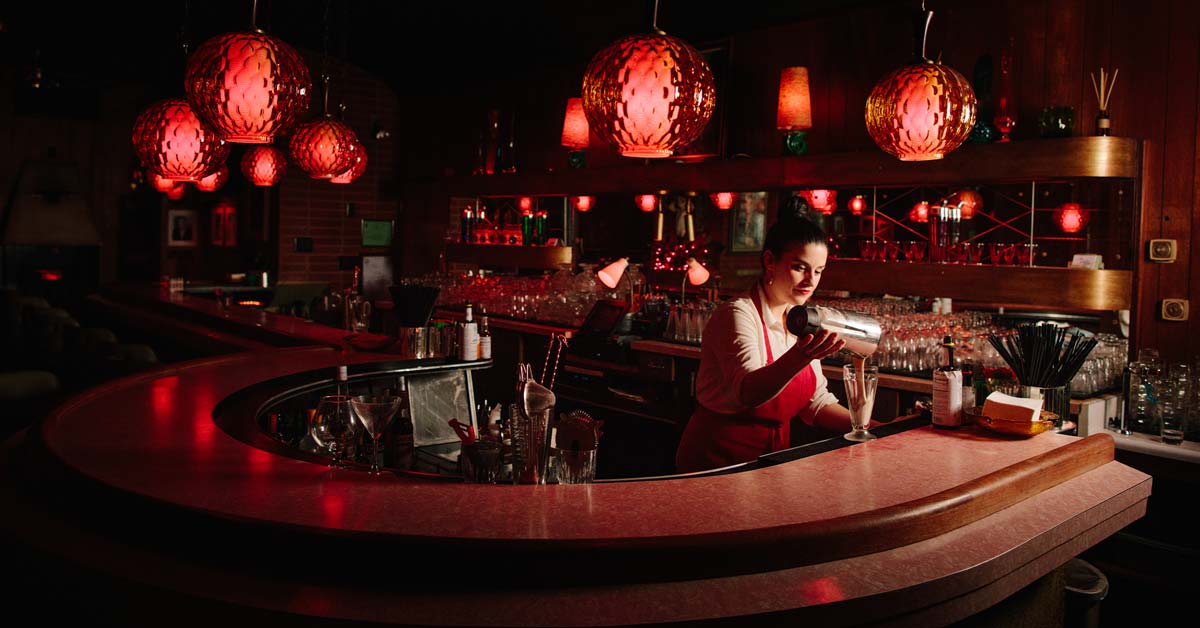
John Dye might not be a native Milwaukeean, but he’s most definitely an avid convert. In 2000, he moved to the city to pursue a Ph.D. in architecture, but found himself enchanted by the unique local bar scene, which is proudly working class, with deep ties to German beer heritage and a strong affinity for friendly neighborhood spots. Turning his back on academia, Dye pivoted. He has spent nearly two decades since as the caretaker of several iconic Milwaukee bars.
Beginning with his purchase of Bryant’s, the city’s oldest cocktail lounge, in 2008, Dye has dedicated himself to renovating and preserving local cultural landmarks, where “long-term owners just kept and held on to these spaces, out of love for the spaces and the customers and the staff,” he says. Sometimes that preservation is simple, but other projects are more involved: His revamp of The Estate, a moody and intimate lounge, took more than a year and a half and involved gutting the space, adding all-new electrical, plumbing and heating systems, and having a structural beam installed. His goal, though, is never to drastically change a bar. To him, the expense and effort pay off when guests barely even realize that the place has changed.
In June of this year, Dye closed on his most recent bar rescue, Von Trier, a German tavern on a busy corner of the city’s east side. Originally called Rieder’s and opened in 1949, the bar changed hands and name in 1978, gaining its appellation from then-owner Karl Lotharius’ hometown in Germany. The space is classic Milwaukee corner bar: high ceilings, knickknacks everywhere, warm wood and stained glass, and even a deer antler chandelier that once hung in the Pabst mansion. “Von Trier is on one of the busiest corners in the city. It definitely would have been a bank drive-through or something, had somebody had the money to buy it out,” he says. “It’s an iconic, historic Milwaukee bar that just needed some shine up.”
Here, Dye shares his outlook on preservation, memory and history, and how they play out in the physical spaces of legacy bars.

Milwaukee has an industrial past that influences the spaces. There was also a very strong middle class here in the ’70s, which is why, I think, a lot of the bars from the ’60s and ’70s thrived here and really made a mark on the city.
That’s the unique thing about the Milwaukee drinking culture: For a while, nobody was really moving to Milwaukee—there just wasn’t this big influx of new residents. One of the reasons so many of these iconic places are still in Milwaukee is because of this economic downfall in the ’80s. Whereas I look at places like Seattle and New York, where they saw this economic boom at different times, and that’s when a lot of those places disappeared. In some ways, the Milwaukee economic condition actually has made it more of a unique city.
A lot of what I do, too, is reactionary against what I see happening in cities. They’re all becoming a little generic. You can go to Chicago, or New Jersey or L.A., and you’ll see the same businesses and the same architecture and the same storefronts. This is kind of boring.
It started with Bryant’s and just realizing that if somebody didn’t take it and preserve it, it was going to close and be gone forever, just like so many of the bars I had heard about as a young person. They were all just memories.
The fact that we build our cities around memories is something that I’ve really come to realize. These [bars] belong to the people. There’s a lot of emotional attachment to them. The way I look at it is, I try to build these spaces to people’s memories of them, more than the actual reality of them, if that makes sense.
The Estate was an extreme example of restoring something to a collective memory. It just made a lot more sense to build the space back to a New York–style jazz club that people described and remember experiencing, rather than the more realistic picture of what we were working with spatially, because their experiences walking into these spaces and patronizing them are more emotionally driven.

Von Trier, Dye’s latest project, originally opened in 1949.
We aren’t planning any major changes at Von Trier, just a lot of cleanup and polishing, lighting changes and some furniture changes. We are lucky that Von Trier was very well built and well taken care of over the years. We kept basically the entire staff. They were younger and very dedicated to the space, so it just seems like a good idea to keep them, and they’re really wonderful, friendly people.
At Bryant’s, which I’ve had for 18 years, we still used National Cash Registers and paper tickets, because it was tradition. We wanted to do it exactly like they had done it for years before, and we were sort of forced into this change [to a more modern system], because there was only one guy who still worked on these beautiful machines that were from the 1950s. But then he retired in 2020.
Even the sound of those old registers is such a part of the space: the ding of the bell and the whir of the machines. We had to replace it all with Toast POS, which is more boring than that. I was really worried, but nobody even noticed. This is one of those things that just, operationally, fit right in, because we were still giving service like they had before.
[Guests] usually describe [our revamped bars] as the same, but “cleaner” or “more orderly than before,” but they can’t put their finger on what changed. It’s funny, it frustrates my carpenter to no end, but I feel we’ve done our job when nobody notices we were there at all.
This interview has been edited and condensed for clarity.







